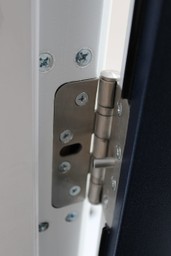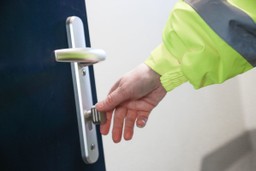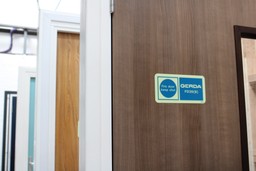UK Fire Door Compliance: An Introduction to Best Practices
Fire door compliance is a vital aspect of maintaining safety in buildings across the UK. Designed to withstand fire and smoke, fire doors serve as barriers, allowing people more time to evacuate and limiting fire damage. This comprehensive guide covers all essential aspects of fire door compliance in the UK, including regulations, installation, maintenance, and… Continue reading UK Fire Door Compliance: An Introduction to Best Practices
Fire door compliance is a vital aspect of maintaining safety in buildings across the UK. Designed to withstand fire and smoke, fire doors serve as barriers, allowing people more time to evacuate and limiting fire damage. This comprehensive guide covers all essential aspects of fire door compliance in the UK, including regulations, installation, maintenance, and inspection requirements.
Key Takeaways
- Regulatory Overview: Key regulations include the Regulatory Reform (Fire Safety) Order 2005 and the Fire Safety (England) Regulations 2022.
- Height-Based Requirements: Multi-occupied buildings over 11 metres have specific quarterly and annual inspection rules.
- Fire Resistance Ratings: Compliance requires fire doors to meet FD30 or FD60 standards, among others.
- Installation and Maintenance: Adhering to installation protocols and regular maintenance preserves fire door integrity.
- Resident Education: Building managers must inform residents about fire doors’ critical safety role.
Understanding Fire Door Compliance: Why It Matters
Fire doors are a crucial part of a building’s fire safety strategy, reducing the speed at which flames and smoke spread. Without compliant fire doors, buildings are significantly more vulnerable in emergencies. Ensuring fire door compliance isn’t just a legal requirement but also a measure that saves lives and property.
The impact of these doors is so substantial that UK regulations have mandated strict standards across various building types, particularly those with high occupancy or elevated risk factors. Compliance with these standards reduces potential liabilities and enhances the overall safety profile of any building.
Legal Framework for Fire Door Compliance in the UK
UK fire door compliance falls under several legislative requirements, with the Regulatory Reform (Fire Safety) Order 2005 (RRO) acting as the cornerstone for fire safety in England and Wales. This law mandates that all non-domestic properties, including commercial and public buildings, install fire doors and maintain other critical fire safety features.
Appointing a Responsible Person
Under the RRO, every non-domestic property must appoint a ‘Responsible Person’ to oversee fire safety protocols, including fire door compliance. This individual has legal responsibility for:
- Conducting risk assessments.
- Implementing fire safety measures.
- Ensuring fire doors are inspected, maintained, and functional.
The role of the Responsible Person extends to keeping thorough records of all fire safety activities. This documentation is not only a compliance requirement but also a crucial resource during safety audits and inspections.
Fire Door Standards: Understanding Fire Resistance Ratings
The fire resistance rating of a door determines how long it can contain fire and smoke. Common classifications include:
Key Fire Door Ratings
- FD30: Designed to withstand fire for 30 minutes, often found in multi-dwelling residential buildings and smaller commercial spaces.
- FD60: Provides 60 minutes of fire resistance, typically used in high-risk or larger buildings.
In addition to these ratings, compliance standards such as BS 476-22:1987 and BS EN 1634-1:2014 are mandatory for new buildings or major renovations, ensuring that fire doors meet rigorous testing protocols.
The resistance level required varies based on building type, occupancy, and potential fire risk. Property managers should consult with fire safety professionals to identify the correct fire door rating for their specific environment.Learn more about communal fire door regulations.
Building Height and Fire Door Regulations
For buildings over 11 metres, the Fire Safety (England) Regulations 2022 introduce specific fire door requirements to ensure that fire doors remain functional and secure.
Quarterly Inspections in Common Areas
In multi-occupied residential buildings exceeding 11 metres, fire doors in common areas must undergo quarterly inspections. This includes doors leading to hallways, stairwells, and other communal spaces. These checks aim to quickly identify any issues that could compromise safety, such as damaged seals or hinges.
Annual Inspections for Flat Entrance Doors
In the same buildings, annual checks are required for flat entrance doors leading to common areas. This annual inspection evaluates whether doors meet all necessary compliance requirements and if any repairs are needed.
Routine inspections are essential for fire door compliance. They reduce the likelihood of unnoticed damage and help prevent potential breaches in fire safety, ensuring that all doors function as effective barriers during an emergency.
Proper Fire Door Installation: Ensuring Compliance from the Start
Installation quality significantly impacts a fire door’s performance. Even the best-rated fire doors won’t perform effectively if installed improperly. Key considerations include:
Fire Door Components to Inspect
- Seals and Hinges: These components must be able to withstand heat without warping or melting. Intumescent seals expand in high temperatures, blocking smoke passage and maintaining the door’s integrity.
- Door Closers: Fire doors should never be propped open, and the door closer is a key component that ensures the door automatically shuts, preventing the spread of fire and smoke.
- Glazing and Viewing Panels: Certain fire doors may include fire-resistant glass, which requires careful installation to maintain fire resistance. Inspectors will check for any modifications to these panels that may reduce their fire-retardant properties.
Maintenance and Inspection Fire Door Requirements
Proper maintenance ensures that fire doors perform as intended throughout their lifespan. The Responsible Person or property manager must organise regular inspections and maintenance, which includes:
- Checking seals and hinges for any visible damage or wear.
- Testing door closers to verify that they automatically close as required.
- Examining glazing panels for cracks, damage, or modifications.
Conducting Visual and Functional Inspections
Visual inspections can reveal many potential issues, but functional tests are also essential. This includes ensuring that door closers operate without sticking and that seals are intact. Inspections must also verify that nothing obstructs the door’s ability to fully close, as an open or partially blocked fire door loses its efficacy.
Explore further: Why regular fire door maintenance is essential.
Documentation: Record-Keeping and Compliance Verification
Maintaining thorough records of all inspections, maintenance, and repairs is a fundamental part of fire door compliance. Detailed records provide a paper trail that demonstrates adherence to regulations. Key documents to keep include:
- Inspection logs detailing dates and findings.
- Maintenance reports documenting repairs or replacements.
- Certification documents confirming that fire doors meet required ratings (e.g., FD30, FD60).
In the event of a fire inspection, these records validate compliance efforts and demonstrate that safety protocols are actively managed.
Educating Residents on Fire Door Importance
In residential buildings with two or more dwellings, the Responsible Person has a duty to inform residents about the importance of fire doors. Educating residents helps prevent accidental tampering and promotes a shared sense of responsibility for building safety.
Key Resident Guidelines
- Do Not Prop Doors Open: Fire doors must remain closed to function effectively in emergencies.
- Report Any Damage Promptly: Residents should be encouraged to report visible damage to fire doors.
- Understand Fire Safety Basics: Providing accessible information on why fire doors are crucial fosters a proactive safety culture.
Building awareness through clear communication supports compliance and reinforces the building’s safety infrastructure.
Fire Door Compliance in New Builds and Renovations
In newly constructed or renovated buildings, compliance with specific British standards, such as BS 476-22:1987 or BS EN 1634-1:2014, is mandatory. Local authority inspectors may request proof of fire door compliance as part of the building approval process.
During the planning stages, project managers should ensure that all specifications for fire doors align with these standards, preventing costly delays or future compliance issues.
Learn about Gateway Compliance Requirements.
Gerda Security: A Trusted Partner in Fire Door Compliance
At Gerda Security, we are committed to providing high-quality fire doors and safety solutions that exceed industry standards. Our range of FD30 and FD60 doors meet strict compliance requirements and are engineered for durability and reliability. With over 25 years of experience in the industry, Gerda Security offers a level of expertise that ensures building managers and property owners can trust in our solutions to enhance fire safety effectively.
Frequently Asked Questions
What is the main fire door legislation in the UK?
The Regulatory Reform (Fire Safety) Order 2005 governs fire door compliance in non-domestic properties in the UK, including installation, maintenance, and inspection requirements.
What is the role of the Responsible Person in fire door compliance?
The Responsible Person is designated to oversee fire safety measures, including fire door compliance, in a building. Their duties include conducting risk assessments, implementing safety measures, and keeping thorough records.
How often must fire doors be inspected?
Fire doors in common areas of multi-occupied buildings over 11 metres should be inspected quarterly, while flat entrance doors require annual inspections.
Why is it essential to keep records of fire door inspections?
Inspection records provide documentation of compliance efforts, which is crucial for regulatory audits. They ensure transparency and help verify that a building adheres to fire safety laws.




